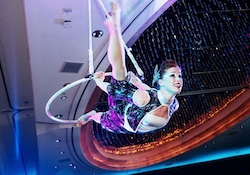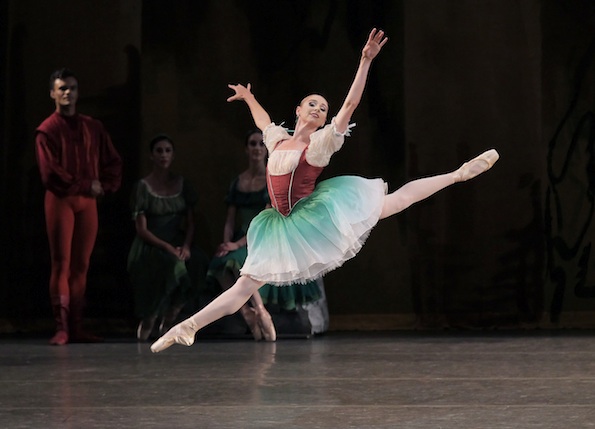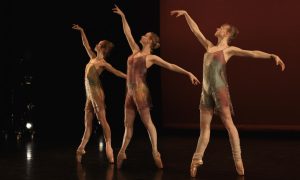By Laura Di Orio.
Even though dancers can spend weeks, even months, rehearsing before a performance, sometimes the stage, lights and audience can dig up some deep nerves. Maybe there’s a special someone watching, or it’s a premiere of a new piece, or maybe those butterflies manage to flutter unwillingly every time. Nerves are natural and often inevitable, so dancers must learn to ease them, deal with them and to perform well, backed by all that hard work in the studio.
“If you think about history, our flight or fight responses served a meaningful purpose in our past: it is what helped our ancestors know that danger was near and is how we protect ourselves,” says Clymene Baugher, M.A., Licensed Mental Health Counselor, and company dancer with Elisa Monte Dance in New York City. “Unfortunately, sometimes in modern times high levels of anxiety may creep in when we would prefer to remain calm. It’s important to realize that it is a normal and natural process that protects us but when we are not in danger, can be mindfully controlled.”
Factors that may trigger pre-performance nerves, and the intensity of those nerves, may vary from dancer to dancer and situation to situation. Ashley Laracey, soloist with New York City Ballet, says nerves heighten when she is about to dance a debut part (or if it’s Marzipan from The Nutcracker, a part she says is very difficult and revealing). Sarah Jean Kaye, a professional dancer and aerialist, says she gets most nervous when she performs in front of her students, whom she wants to impress. Anna Liceica, former dancer with NYCB and American Ballet Theatre and now a principal guest artist, says she is usually excited rather than nervous before shows, but there are some exceptions – when she was asked to dance Jewels at NYCB without much rehearsal, or when she performed group Balanchine repertory, because she says there are so many things to worry about. Sarah Braverman, dancer with Parsons Dance, says she always feels a bit nervous before a show but that if she didn’t feel that rush of nervous excitement she’d know she has a problem.

Sarah Jean Kaye, a dancer and aerialist, in performance. Photo by Lina Monroy Photography.
“In some ways, those nerves are why I love dancing and performing so much,” Braverman says. “It reminds me of how alive I feel in that moment. Live dance is so exciting because of the risk factor.”
Baugher explains that there is positive and negative anxiety. “A positive level of anxiety is just what a dancer needs to harness their adrenaline and push themselves to provide their best performance,” she says. “However, too much, or negative anxiety, will have a reverse effect and be just enough to throw a dancer off his/her performance. No level of negative stress will give birth to an amazing performance.”
Each dancer may find different tactics that work to ease nerves, or help channel that positive anxiety.
Braverman’s pre-show routine, consisting of Diet Coke, toe tape, exactly one-half of a chocolate chip cookie and 50 sit-ups, helps get her into the right frame of mind. She also makes sure to get to the stage at half-hour to work through trouble spots in the choreography, check her entrances and exits, feel the floor and pre-set quick changes.
“One of the most important things is being present with the company members I am about to dance with,” Braverman adds. “The energy and support we have the ability to give each other is invaluable. That is vital for me.”
Laracey’s routine begins with make-up and hair two hours prior to showtime, with country music playing in her headphones. She then eats a banana and warms up, while thinking about the ballet and visualizing how she would like to see herself dancing it, confidently and beautifully.
Laracey says she does like to keep moving but doesn’t practice the technical steps too much right before the performance. “Practice your tricky turn once, then leave it,” she advises. “Don’t overdo it. You don’t want to give yourself a complex!”
For Kaye, the most important thing before a performance is that her body is hot. “I milk a few cups of tea, turn the thermostat up and get in my dance snugggie,” she says. “I always try to take a bath before all aerial gigs. If I don’t get the best warm-up in but am hot it helps me mentally.”
Liceica says that she likes to start her performance day as normally as possible, with class, a bit of rehearsal and a power nap. She also prefers to eat lighter foods and coffee to keep her energy up.
Baugher says it’s important that dancers take care of themselves – body, mind and spirit – and to have faith in their training and muscle memory, and also to think positively.
“The mind is a very powerful tool, and it can deceive you,” Baugher says. “It is important to not ‘syke’ oneself out before a show or think too many negative thoughts, as these will most definitely find their way on stage, potentially becoming a self-fulfilling prophecy. It is an inner peace or calmness that each dancer should find for themselves, a sharp mental focus and awareness of the here-and-now that is not shrouded in self-doubt or negative, obsessive thinking.”
But what happens when, even if dancers settle their nerves before the show, those thoughts, nerves or fears sneak up mid-performance?
“When things do not go well onstage, a dancer only has a split second to recover mentally and emotionally before it affects the next moment or even the entire company,” Baugher explains. “A dancer has to be skilled at being present, and by that I mean that no other moment is important except what is happening in the now. Essentially, on stage there is no past and no future, only what is occurring in the moment. Do not let your mind obsess over the mistake that was made or worry about what is yet to come.”
Although Braverman says there are times when those sneaky, mid-performance nerves arise, she is thankful for muscle memory built up during all those hours of rehearsal. “In those moments, I find myself really listening to the music and asking myself to be present in the moment,” she adds. “I also find a great sense of calmness by looking at who I am performing with, or those in the wings. A little eye contact with another dancer can be so comforting.”
Kaye says that a little mental conversation can help her during aerial shows. “Hanging upside down seems to slow down time,” she says. “A lot of times, I am holding poses where I can say, ‘You are almost there, keep going!’ I have hung as high as 35 feet, which, if you get in your head at that time, your performance can go south!”
Most importantly, professionals often say that, despite nerves, or in spite of them, dancers should try to enjoy the special moment on stage.
“It helps to remember that, in essence, the audience is there to love and enjoy your performance,” Liceica says. “They want to relax and have a good time, which is why you should do the same.”
Baugher concludes, “Realize that dance is a gift to one’s soul and to the audience. There is then no such thing as a mistake. Dance and performances should be enjoyed, not labored over in our minds. Free yourself. Try and have fun. Happiness helps you bond with your fellow dancers and places you in a positive frame of mind. When it’s time to step on stage, you have to have faith that you have done ‘the work’ and accept that your only job is to enjoy and give to the audience.”
Photo (top): Ashley Laracey, soloist with New York City Ballet, in Peter Martins’ Swan Lake. Photo by Paul Kolnik.















